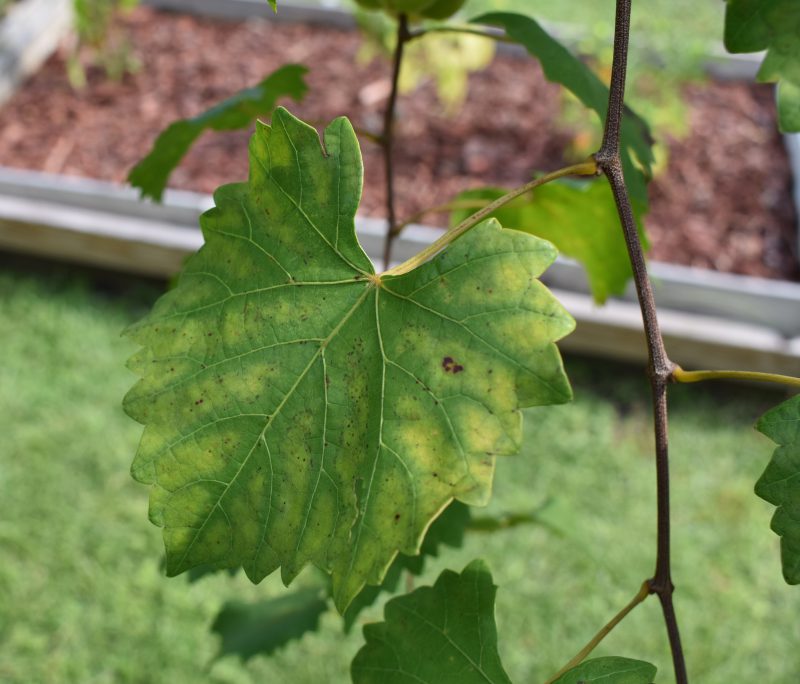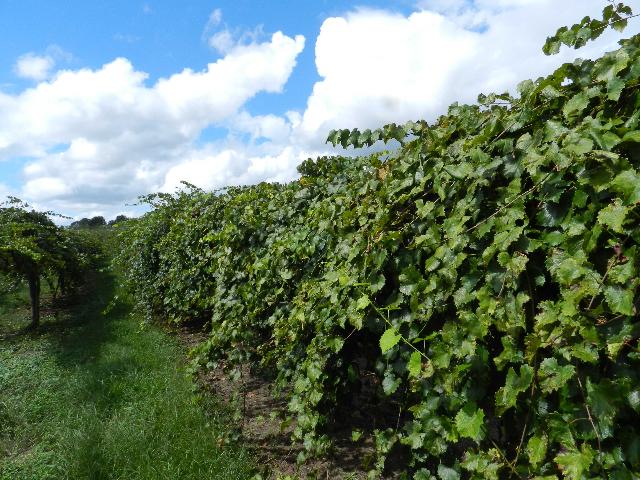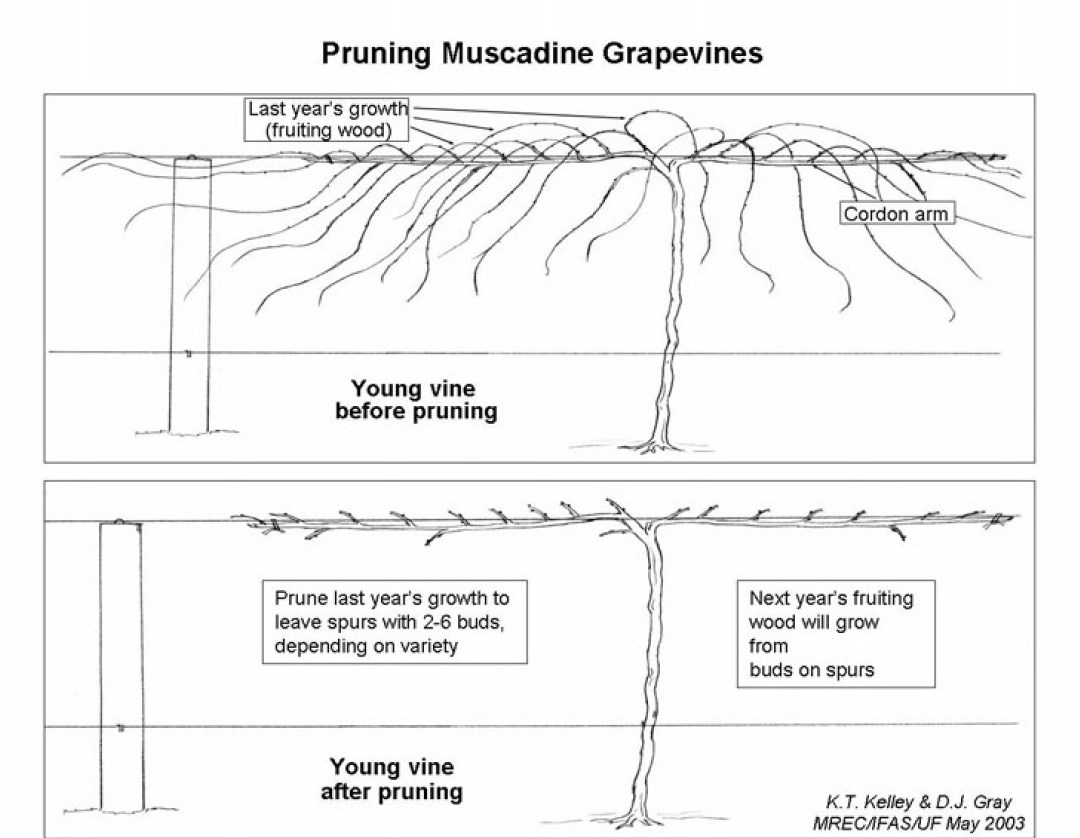
Muscadine, also known as scuppernong, cultivar ‘Granny Val‘ is not yet ripe in Mid-August, but will be soon. Credit Matthew Orwat, UF/IFAS , 2019
Although muscadine harvest can begin as early as July and as late as September, peak time is just beginning for the bulk of the muscadines grown in the Florida Panhandle. Generally, muscadines do not store well or last long after harvest, so growers need the ability to spread out the harvest season. This may be accomplished by planting a mix of early, mid, and late bearing cultivars which maximizes the availability of fresh product throughout the harvest season.
Northwest Florida farms grow muscadines as a substitute for traditional grape (Vitis vinifera) cultivars such as ‘Concord’ or ‘Thompson’s Seedless’, since these cultivars are prone to Pierce’s Disease. In fact, muscadines are native to the Southeastern US, and are resistant to a variety of insect and disease pests. This is a significant advantage, because the need for insecticides or pesticides in production can be lower than many other fruit crops.
An additional advantage of growing muscadines is that they can easily be asexually propagated. To mimic the natural asexual propagation of wild muscadines, growers may use the pegging method to duplicate non-patented or varieties in which patent has expired (20 years from introduction). Pegging entails wounding the branch in several locations, then burying the wounded section of the branch in moist soil, while leaving the shoot tip exposed. If this is done in the late spring or summer, roots should form from the main branch in about a month. After roots are confirmed, the connection with the mother plant can be cut.
If you utilize purchased transplants, planting time for muscadines depends on the type of plant material you select. Bare root vines should be planted between December and January, but containerized plants can be planted any time.

Slight Magnesium deficiency in older leaf on muscadine. Can be corrected with application of proper amount of dolomitic lime or epsom salts. Image Credit: Matthew Orwat, UF/IFAS Extension, 2019
Before muscadines are planted, soil tests should be performed to determine pH. Muscadines can be grown in the pH range of 5.5 to 7.0, with the optimal level between 6.0-6.5. Since many soils in Northwest Florida are acidic, tests should be done at least 3 months before planting. This will allow the addition of an optimal lime source, Dolomite, which takes approximately 3 months to raise the pH, but also adds magnesium to the soil.
Once harvest concludes, it is usually a grower’s natural inclination to immediately prune their muscadine vines. However, pruning immediately after harvest, in early fall, is not best for maintaining plant condition and optimizing next year’s yield, especially if there is an early frost. Early frosts can surprise the plant before sugars have been moved to the roots for storage during dormancy. Therefore, waiting to prune in mid-January to mid-March will ensure that the vine has had adequate time to go dormant and acclimate for the winter season.
Muscadines flower and fruit on shoots from the current, not previous, years growth. These new bearing shoots arise from the leaf axils of the previous years’ growth. Pictured above is the bi-lateral cordon training system. This is the most popular system for muscadine production.
Pruning must be performed to maintain this configuration. If vines are too vigorous, it is acceptable to prune lightly throughout the growing season. Vines must also be trimmed to at least 2 feet above the ground before herbicides are applied for weed control. Non-selective systemic herbicides will not enter grapevines through hardened bark. However, these herbicides must not come in contact with green tissue, or they will be absorbed and damage the plant.
Using the bi-lateral cordon system, there are two main branches or “cordons” of the vine. Along each cordon, fruiting spurs should be spaced approximately every six inches. Each fruiting spur should contain 2-4 nodes. If fruiting spurs become more than one foot from the cordon, it is time for spur renewal. This is typically done every 3-6 years. If they lose productivity, entire spurs can be removed, they will be replaced by new shoots. Additionally, cordons may lose productivity or die off after 5 to 10 years of production. If this occurs, simply remove the cordon and train a new or existing branch into a new cordon. Pruning with a design in mind, and at the proper time will enhance the performance and longevity of muscadine vineyards.
Information from this article was derived from The Muscadine Grape
Also see Basic Considerations for Pruning Grapevines
Here is a list of recommended cultivars for fresh market:
Early
- Black Fry – Black
- Tara – Bronze
Mid Season
- Black Beauty (mid to late)- Black
- Fry – Bronze
- Farrer – Black
- Supreme (mid to late) – Black
- Southern Home – Black
- Pam – Bronze
- Pineapple (mid to late) – Bronze
Late
- Nesbitt – Black
- Polyanna – Black
- Doreen – Bronze
- Granny Val – Bronze
To learn more about pruning and different training techniques, please consult:
The Muscadine Grape, Publication #HS763
- Steps to Remedy Non-Productive Pecan Orchards - June 30, 2023
- If Not Disease, Then What? Abiotic Vegetable Disorders - June 24, 2022
- Dormant Sprays Protect Fruit Trees from Future Insects and Diseases - January 28, 2022


